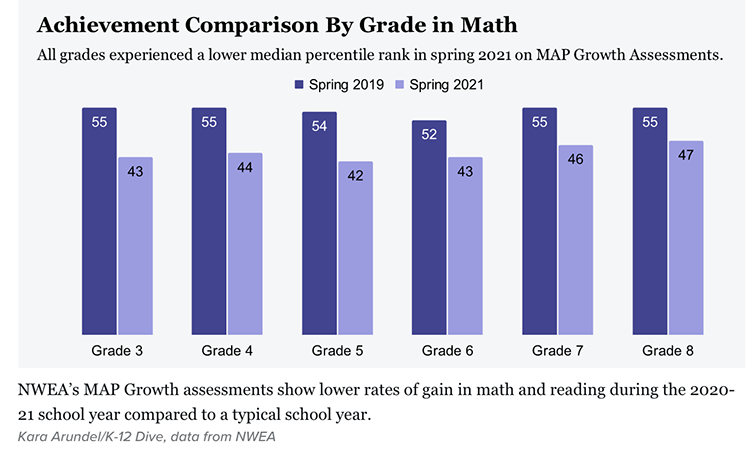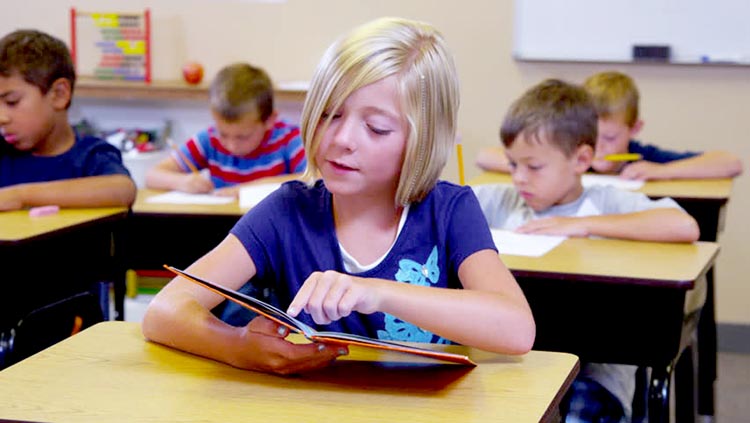
Three separate assessment analyses show younger students, students of color and low-income students had lower rates of academic gains.
From K-12 Dive
By Kara Arundel and Naaz Modan
July 28, 2021
Separate reports released this week by NWEA, Amplify and McKinsey & Company confirm end-of-year learning gains lag those made prior to the pandemic. The research from the three testing and consulting organizations shows student progress fell short in math and reading, with disparities varying along race and income lines.
Attrition means gains may be overestimated
National data from NWEA’s MAP Growth assessments from the 2020-21 school year shows students made academic progress in both reading and math over the school year, but that progress was at a slower pace compared to testing data from past school years.
The testing results released Wednesday are cause for both optimism — because of the modest school-year upward trajectory of math and reading gains — and concern — because of the lower rates of gains compared to a typical school year, particularly for students of color and students attending high-poverty schools, said NWEA Senior Research Scientist Karyn Lewis.
NWEA’s recent analysis focuses on assessment results from 5.5 million students in grades 3-8 who took the computer adaptive tests at up to three points during the 2020-21 school year. Like testing results from fall 2020, the latest assessment analysis shows larger declines in math achievement compared to reading test results.
Reading achievement in spring 2021 was 3 to 6 percentile points lower than pre-pandemic achievement levels. Average math performances were worse, at 8 to 12 percentile points lower than a typical year.

Digging deeper into data disaggregated by grade and student subgroups shows a more worrisome picture, Lewis said. For example:
Younger students, such as those in grade 3, had declines in math and reading performance larger in magnitude than results from older students.
The greatest rates of decline were experienced by Black and Latinx students in grades 3-5 in reading, and by students taking math assessments in grades 3-5 who identify as American Indian and Alaska Native, Black and Latinx.
Students in high-poverty schools had a greater decline in median achievement percentile points, which on average was nearly double that of low-poverty schools from 2019 to 2021.
Overall, learning gains were more sluggish between winter and spring testing, an unexplained finding, Lewis said.
“I think I had some hope that we might start to see some signs of recovery as kids were more likely to be learning back in the classroom, but I think even being back in the classroom, for some kids, it didn’t look anything like normal times,” Lewis said.
Lastly, the NWEA report notes the testing data from this past school year had a higher rate of attrition than typical. Specifically, 1 in 5 students who tested during the previous year were missing from this year’s pool even though the tests could be administered remotely, Lewis said. That 20% attrition rate is higher than historically recorded.
Additionally, attrition rates for students who identify as American Indian and Alaska Native, Black and Latinx, are even higher, leading some researchers to caution academic achievement and gains in 2020-21 may be overestimated compared to prior school years.
“As bleak as these results are, it might be a best-case scenario, because we’re missing a lot of the kids from these groups that were hardest hit” by the pandemic, Lewis said.
Separate reports confirm lags in learning
A separate report from McKinsey & Company quantified the impact of learning lags on the groups hardest hit, namely Black, Hispanic and low-income students. In line with the consulting firm’s previous predictions, the company found students are, on average, five months behind in math and four months behind in reading compared to where they were this time last year.
The number was greater for Black and Hispanic students, both of which ended the year six months behind in math while their White counterparts finished four months behind. Lags in math, however, were still most pronounced for low-income students, who finished the year seven months behind expectations on average.
In reading, differences between Black and White students were double, with students six and three months behind, respectively. Hispanic students were five months behind.
A separate report released by Amplify shows those trends persisted for students in early grades as well.
End-of-year data from about 400,000 students in over 1,400 schools, which tended to be in large urban metro areas, shows losses in literacy also impacted younger students in grades K-3 compared to years prior to the pandemic. The differences were most pronounced among Black and Hispanic students, who had gaps when compared to their White counterparts in every early grade.
However, in 1st and 3rd grades especially, Black students increasingly were placed in high-risk categories while fewer White students were flagged, and in some cases the latter group even improved.
In 1st grade, there was an increase of 12 percentage points for Black students placed in high-risk categories and only one percentage point for White students. In 3rd grade, there was an increase of 10 percentage points for Black students in high-risk groups, and a decrease of seven percentage points for White students, meaning there were fewer 3rd-grade White students in the high-risk category than before the pandemic.
“The big picture is that while students across grades and sub-groups have made progress this year, struggling Hispanic and Black students are still catching up to middle-of-year levels” from prior to the pandemic, said Paul Gazzerro, director of data analysis at Amplify, in an email.
That big picture also includes longterm implications, which, according to McKinsey & Company, means today’s students could earn between $49,000 to $61,000 less during their lifetime due to the pandemic’s impact on their learning unless schools intervene.
Emergency funding ‘important piece of this recovery’
In addition to releasing the reading and math assessment results, NWEA also issued three pages of policy recommendations to support pandemic recovery in schools. The recommendations include:
Expanding instructional time and opportunities for students.
Continuing to provide access to remote learning technology for students.
Providing professional development opportunities for educators.
Using formative, interim and summative assessments to measure students’ progress.
Chris Minnich, NWEA chief executive officer, said schools can access money from the Elementary and Secondary School Emergency Relief fund, a federal coronavirus relief initiative, to support learning recovery. “There is money in the system, and how you use that money now is a really important piece of this recovery,” he said.
Lewis, the NWEA researcher, also suggests local school systems review their MAP Growth assessment data to determine what programs need the most support. Lindsay Dworkin, NWEA vice president of policy and advocacy, agreed, saying understanding what the data says about the students most impacted can help inform local recovery efforts.
“Find and re-engage your missing kids. Get your kids back into your community, because you have to start there,” Dworkin said.
Photo: Shutterstock
Read this and other stories at K-12 Dive

